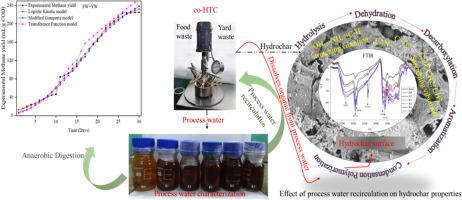Science of the Total Environment ( IF 9.8 ) Pub Date : 2021-10-16 , DOI: 10.1016/j.scitotenv.2021.150748 Hari Bhakta Sharma 1 , Sagarika Panigrahi 1 , Kumar Raja Vanapalli 2 , V R Sankar Cheela 1 , Saikrishna Venna 3 , Brajesh Dubey 1

|
The commercial success of hydrothermal carbonization (HTC) is contingent on seeking solutions for the downstream wastewater (process water) generated during the process which is still regarded largely as a nuisance. In the present study, the reusability and valorization strategy of process wastewater generated during co-HTC of organic fraction of municipal solid waste (food and yard waste) at 220 °C for 1 h was established. The process wastewater was anaerobically digested in the first part to determine its methane-generating capacity; and in the second part, it was recirculated up to five times to understand the evolution of physicochemical and fuel characteristics of hydrochar. The process water was characterized by the presence of high total organic carbon (up to 40 g/L) and chemical oxygen demand (up to 96 g/L). The decreasing trend of heavy metals with increasing recirculation suggested possible adsorption/immobilization mechanism taking place to the hydrochar surface. The process water generated from co-HTC condition has anaerobic biodegradability of 72% while experimental and theoretical methane yield observed were 224 mL/g COD and 308 mL/g COD, respectively. The presence of high organic and ionic species in recirculated process water promoted the overall carbonization process which was evident from the increased energy yield (86 to 92%), carbon content (68 to 71%) and calorific value (20 to 27 MJ/kg). The recirculation also enhanced overall combustion characteristics of hydrochar as analyzed by thermogravimetric analysis. The recirculation strategy enhanced fuel properties of hydrochar while making sure upstream and downstream water related burden is reduced (as illustrated by life cycle analysis) to create a cleaner production system for renewable solid biofuels production.
中文翻译:

餐厨垃圾水热共碳化工艺废水回用与增值研究
热液碳化 (HTC) 的商业成功取决于为该过程中产生的下游废水(工艺用水)寻求解决方案,这在很大程度上仍被认为是一种麻烦。在本研究中,建立了城市固体废物(食物和庭院废物)的有机部分在 220 °C 下共 HTC 1 小时产生的工艺废水的可重复使用性和价值化策略。第一部分对工艺废水进行厌氧消化以确定其产甲烷能力;在第二部分中,它被再循环了五次以了解水炭的物理化学和燃料特性的演变。工艺用水的特点是存在高总有机碳(高达 40 g/L)和化学需氧量(高达 96 g/L)。重金属随着再循环增加而减少的趋势表明可能发生在水炭表面的吸附/固定机制。co-HTC 条件产生的工艺水具有 72% 的厌氧生物降解性,而观察到的实验和理论甲烷产量分别为 224 mL/g COD 和 308 mL/g COD。循环过程水中高有机物和离子物质的存在促进了整个碳化过程,这从能量产率(86 至 92%)、碳含量(68 至 71%)和热值(20 至 27 MJ/kg)的增加中可见一斑。 )。通过热重分析分析,再循环还增强了加氢炭的整体燃烧特性。


























 京公网安备 11010802027423号
京公网安备 11010802027423号